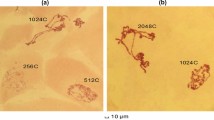Summary
-
1.
The composition of the larval saliva in Chironomus tentans is different from that of the larval saliva of all other Chironomus species investigated so far, including C. pallidivittatus, a sibling species of C. tentans. The difference is limited to a group of 4 cells which form a special lobe of the salivary gland and which, in C. tentans, fail to produce a special kind of secretion granules that is present in all other species. The presence of these specific granules (“SZ” granules) is easily detected by their tendency to “blow up” in alcohol, even after fixation. The fine structure of the special cells in C. tentans is not different from that observed in the other species.
-
2.
Crosses between C. tentans and C. pallidivittatus show that the inability to produce SZ granules is inherited as a simple recessive Mendelian character („sz“). The special salivary lobe of the hybrid produces an intermediate amount of SZ granules.
-
3.
The major chromosome regions of C. tentans and of C. pallidivittatus differ by inversions which can be used as markers in locating the mutation “sz”. The locus of “sz” is shown to be in the small 4th chromosome, either in its distal regions or directly adjacent to the kinetochore.
-
4.
Directly adjacent to the kinetochore of chromosome 4 a Balbiani ring (conspicuous puff) has been found to occur in the special salivary gland cells of C. pallidivittatus. It fails to appear in the rest of the gland. This specific puff, “BR 4 (SZ)”, is not present in the special salivary gland cells of C. tentans. In hybrids the SZ puff is “heterozygous”, i.e. of the two 4th chromosomes only that one shows the puff which also carries the dominant allele “sz +”. Furthermore, there is a close parallel between the expression of the allele sz + and the visible “expression” of the puff.
-
5.
All observations lead to the conclusion that the specific puff of the special salivary lobe, “BR 4 (SZ)”, represents the activated locus of the allele “sz +” which controls a specific function of just this lobe of the gland. This result confirms the view that the puffs are active loci governing the specific functions of the differentiated cell.
-
6.
Some further implications of the findings are discussed. In particular, it is thought that large puffs, such as the Balbiani-rings, may represent loci which supply the genetic information for non-enzyme proteins, e.g. the proteins of the saliva.
Similar content being viewed by others
Literatur
Bauer, H.: Die Chromosomen im Soma der Metazoen. Zool. Anz. Suppl. 17, 252–268 (1953).
—, u. W. Beermann: Die Polytänie der Riesenchromosomen. Chromosoma (Berl.) 4, 630–648 (1952).
Beermann, W.: Chromomerenkonstanz und spezifische Modifikationen der Chromosomenstruktur in der Entwicklung und Organdifferenzierung von Chironomus tentans. Chromosoma (Berl.) 5, 139–198 (1952a).
—: Chromosomen-struktur und Zelldifferenzierung in der Speicheldrüse von Tricnocladius vitripennis. Z. Naturforsch. 7b, 237–242 (1952b).
—: Geschlechtsbestimmung und Evolution der genetischen Y-Chromosomen bei Chironomus. Biol. Zbl. 74, 525–544 (1955a).
—: Cytologische Analyse eines Camptochironomus-Art-bastards. I. Kreuzungsergebnisse und die Evolution des Karyotypus. Chromosoma (Berl.) 7, 198–259 (1955b).
—: Inversions-Heterozygotie und Fertilität der Männchen von Chironomus. Chromosoma (Berl.) 8, 1–11 (1956).
—: Chromosomal differentiation in insects. In: Developmental Cytology, edit. D. Rudnick. New York: Ronald 1959.
—, and G. F. Bahr: The submicroscopic structure of the Balbiani-ring. Exp. Cell Res. 6, 195–201 (1954).
Breuer, M. E., and C. Pavan: Behavior of polytene chromosomes of Rhynchosciara angelae at different stages of larval development. Chromosoma (Berl.) 7, 371–386 (1955).
Clever, U., u. P. Karlson: Induktion von Puff-Veränderungen in den Speicheldrüsenchromosomen von Chironomus tentans durch Ecdyson. Exp. Cell Res. 20, 623–626 (1960).
Mechelke, F.: Reversible Strukturmodifikationen der Speicheldrüsen-Chromosomen von Acricotopus lucidus. Chromosoma (Berl.) 5, 511–543 (1953).
—: Strukturmodifikationen in Speicheldrüsenchromosomen als Manifestation eines Positionseffektes. Naturwissenschaften 47, 334–335 (1960).
Pelling, C.: Chromosomal synthesis of ribonucleic acid as shown by the incorporation of uridine labeled with tritium. Nature (Lond.) 184, 655–656 (1959).
Sirlin, J. L.: Cell sites of RNA and protein syntheses in the salivary gland of Smittia (Ghironomidae). Exp. Cell Res. 19, 177–180 (1960).
Wagner, R. P., C. E. Somers and A. Bergquist: Gene structure and function in Neurospom. Proc. Nat. Acad. Sci. (Wash.) 46, 708–717 (1960).
Author information
Authors and Affiliations
Additional information
Professor Franz Schrader zum 70. Geburtstag gewidmet. — Mit Unterstützung der Deutschen Forschungsgemeinschaft.
Rights and permissions
About this article
Cite this article
Beermann, W. Ein Balbiani-Ring als Locus einer Speicheldrüsen-Mutation. Chromosoma 12, 1–25 (1961). https://doi.org/10.1007/BF00328911
Received:
Published:
Issue Date:
DOI: https://doi.org/10.1007/BF00328911




